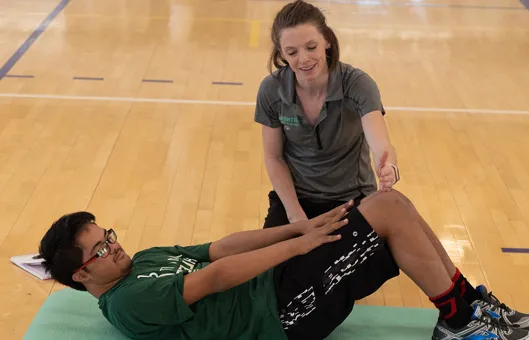Butt & Hip Exercises
Forward Cone Jumps
- Target Body Part:
- Butt/Hips, Legs - Thighs
- Equipment:
- Cones
- Difficulty:
-
 Intermediate
Intermediate
Step 1
Starting Position: Place a series of cones 18-24" apart in a straight line on a non-slip surface. Stand 6" behind the first cone with your feet hip-width apart or closer, arms by your sides. Depress and retract your scapulae (pull your shoulders down and back) without arching your low back, and "brace" (engage your abdominal / core muscles) to stiffen your spine.
Step 2
Downward Phase: Begin your downward phase by first shifting your hips backwards then slowly moving downwards to create a hinge-like movement at your knees. Continue to lower yourself until your feel your heels about to lift off the floor. Try to maintain a flat back by bending forward at the hips. Keep your head facing forward or to the floor, and position your arms where comfortable or where they offer the greatest degree of balance support.
Step 3
Jumping Movement: With ONLY a very brief pause at the bottom of your downward phase, explode forward and upwards through your lower extremity over the top of the first cone, achieving triple extension (pushing and extending your ankles, knees and hips simultaneously). As your jump into the air, try to keep your feet level with each other and parallel with the floor.
Step 4
Landing: The most important components of the landing phase are correct foot position and avoiding excessive forward movement in your lower extremity which places additional stresses upon your knees.
Step 5
Attempt to land softly and quietly on the mid-foot, rolling backwards quickly towards the heels to create a level foot, parallel with the floor. Always push your hips backwards and drop your hips to absorb the jumping forces. Avoid locking your knees or quads on your landing as this may lead to potential knee injuries.
Step 6
Land with your trunk inclined slightly forward, head aligned with your spine and back rigid or flat. Keep your abdominal / core muscles engaged, stiffening your torso to protect your spine.
Step 7
With ONLY a very brief pause at the bottom of your landing phase, explode forward and upwards again through your lower extremity over the second cone, achieving triple extension (pushing and extending your ankles, knees and hips simultaneously). As you jump into the air, try to keep your feet level with each other and parallel with the floor. Continue this process until you have cleared all the cones.
Step 8
Exercise Variation: As you develop your jumping and landing skills, you can progress the exercise intensity and complexity by: (1) driving your arms behind you during the downward phase, (2) driving your arms forward and upward (towards an overhead position) during the jumping phases, (3) driving your knees towards your chest during the jumping phases, (4) increasing the height of each cone or the spacing between each cone, or (5) moving back and forth more rapidly or adding more cones and performing a greater number of jumps in each direction.
Share:

Inclusive Fitness Training
Create fitness opportunities for people with intellectual disabilities!
Learn MoreCourse!




